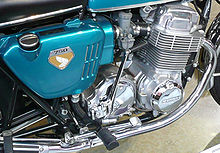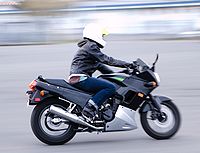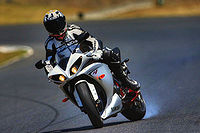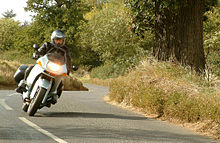- Sport bike
-
 A BMW S1000RR sport bike on the track.
A BMW S1000RR sport bike on the track. Main article: Types of motorcycles
Main article: Types of motorcyclesA sport bike, also written as sportbike, is a motorcycle optimized for speed, acceleration, braking, and cornering on paved roads,[1][2][3][4] typically at the expense of comfort and fuel economy in comparison to less specialized motorcycles.[5][6] Soichiro Honda wrote in the owner's manual of the 1959 Honda CB92 Benly Super Sport that, "Primarily, essentials of the motorcycle consists in the speed and the thrill," while Cycle World's Kevin Cameron says more prosaically that, "A sportbike is a motorcycle whose enjoyment consists mainly from its ability to perform on all types of paved highway – its cornering ability, its handling, its thrilling acceleration and braking power, even (dare I say it?) its speed."[7]
Motorcycles are versatile and may be put to many uses as the rider sees fit. In the past there were few if any specialized types of motorcycles, but the number of types and sub-types has proliferated, particularly in the period since the 1950s.[8] The introduction of the Honda CB750 in 1969 marked a dramatic increase in the power and speed of practical and affordable sport bikes available to the general public.[8][9][10][11][12]
 The groundbreaking inline four of the Honda CB750.
The groundbreaking inline four of the Honda CB750.
This was followed in the 1970s improvements in sport bike suspension and braking commensurate with the power of the large inline fours that had begun to dominate the sport bike world. In the 1980s sport bikes again took a leap ahead, becoming almost indistinguishable from racing motorcycles.[5][9][12][13] Since the 1990s sport bikes have become more diverse, adding new variations like the naked bike and streetfighter to the more familiar road racing style of sport bike.[8][12][14]
Contents
Design elements
 Aftermarket upgrades using carbon fiber or other exotic materials are used on sport bikes to enhance the power-to-weight ratio and handling.
Aftermarket upgrades using carbon fiber or other exotic materials are used on sport bikes to enhance the power-to-weight ratio and handling.
With the emphasis of a sport bike being on speed, acceleration, braking, and maneuverability, there are certain design elements that most motorcycles of this type will share. Rider ergonomics favor function. This generally means higher foot pegs that move the legs closer to the body and more of a reach to a lower set of hand controls, such as clip on handlebars, which positions the body and weight forward and over the tank.[4][6] Sport bikes have comparatively high-performance engines resting inside a lightweight frame.[6] High tech and expensive materials are often used on sport bikes to reduce weight.[6]
Braking systems combine higher performance brake pads and disc brakes with multi-piston calipers that clamp onto oversized vented rotors. Suspension systems are advanced in terms of adjustments and materials for increased stability and durability. Front and rear tires are larger and wider than tires found on other types of motorcycles to allow higher cornering speeds and greater lean angles. Fairings may or may not be used on a sport bike; when used, fairings are shaped to reduce aerodynamic drag as much as possible and provide wind protection for the rider.[6]
The combination of rider position, location of the engine and other heavy components, and the motorcycle's geometry help maintain structural integrity and chassis rigidity, and determine how it will behave under acceleration, braking, and cornering. Correct front-to-rear weight distribution is of particular importance to the handling of sport bikes, and the changing position of the rider's body dynamically changes the handling of the motorcycle.[15] Because of the complexity of modeling all the possible movements of different sized riders, to approach perfect tuning of a motorcycle's weight distribution and suspension is often only possible by having a bike customized or at least adjusted to fit a specific rider.[15] Generally, road racing style sport bikes have shorter wheelbases than those intended for more comfortable touring, and the current trend in sport bike design is towards shorter wheelbases, giving quicker turning at the expense of a greater tendency for unintentional wheelies and stoppies under hard acceleration and braking, respectively.[15][16][17]
Classes
The Kawasaki Ninja 250R lightweight sport bike.The Triumph Daytona 675 triple is usually classed as a middleweight or supersport.A Yamaha YZF-R1 998 cc (60.9 cu in) superbike.Touring with a passenger on an open class Suzuki Hayabusa.There is no universal authority defining the terminology of sport bikes or any other motorcycle classes. Legal definitions are limited by local jurisdiction, and race sanctioning bodies like the American Motorcyclist Association (AMA) and the Fédération Internationale de Motocyclisme (FIM) set rules that only apply those who choose to participate in their competitions. Nonetheless, by present day standards in Europe, North America and the rest developed world, sport bikes are usually divided into three, four, or five rough categories, reflecting vaguely similar engine displacement, horsepower, price and intended use, with a good measure of subjective opinion and fudging for the sake of simplicity. Marketing messages about a model from the manufacturer can diverge from the consensus of the motorcycling media and the public. Sometimes the classes used in motorcycle racing are approximated in production models, often but not always in connection with homologation.
The sport bike classes in common usage are:[12][18][19]
- Lightweight, also called entry level, small or beginner bikes.[14][20][21] Some two strokes in this class have dramatically higher performance than the four strokes, being likened to miniature superbikes.[12] Sport bikes with engine displacements of up to about 500 cc (31 cu in) are usually in this class.[4]
- Middleweight,[18] mid-sized, mid-level,[14] or supersport.[12] Some of the models in this range qualify for racing in the classes AMA Supersport Championship, British Supersport Championship and the Supersport World Championship, but many middleweights do not have a significant presence in racing. Displacements of 600–750 cc (37–46 cu in) are typical.[4]
- Superbike,[18] liter-class, or literbike, i.e 1,000 cc (61 cu in).[4] As with supersport, many of the models in this class compete in superbike racing.
- Open class, hypersport or hyperbike[20][22][23] are terms sometimes used in lieu of superbike as a catch-all for everything larger than middleweight.[19][20][24][25][26] Alternatively, these terms mark a class above the superbikes for the largest displacement sport bikes with the highest top speeds, with weights somewhat greater than the superbike class.[4][8][27][28]
The terms supersport and superbike are sometimes applied indiscriminately to all high performance motorcycles.[29][30][31][32] Categorization by engine displacement alone is a crude measure, particularly when comparing engines with different numbers of cylinders like inline or V fours with parallel and V twins, not to mention the greater power for a given displacement of two-stroke engines over four strokes.[14]
In the less developed world, smaller engine sizes are the norm, and relative terms like small, mid sized and large displacement can have different meanings. For example, in India in 2002 there were about 37 million two-wheelers,[33] but as of 2008, there were only about 3,000 motorcycles, or fewer than one in 12,000, of displacement 1,000 cc (61 cu in) or more.[34] Similarly, the perception of relative sizes has shifted over time in developed countries, from smaller to larger displacements.[35] When the original superbike,[9][11] the Honda CB750, appeared in 1969, it was called a "big four,"[8] while today an inline four of 736.5 cc (44.94 cu in) would be classed in the middle range.
Besides having product lines that span from entry level through high end sport bikes, many manufacturers add depth[36] to that line by having pairs, or several pairs, of similar sport bikes aimed at riders of different levels. These are designed to appeal to riders seeking more or less extreme performance features. The more expensive model will be in the vein of a race replica, offering the latest technology updated with frequent design revisions, while the lower cost model typically relies on older technology, can have a more relaxed riding position, and is generally more practical for non-road racing tasks such as urban commuting and carrying passengers or baggage, and offering lower fuel, insurance and maintenance costs. Examples of these paired models are Buell's Firebolt and Lightning, Ducati's 916/748 through 1198/848 paired series, Honda's CBR600RR and F4i middleweights[8] and RC51 and CBR1000RR liter-class, several different concurrent models in Kawasaki's Ninja line, and Yamaha's R6 and 600R.[4]
Variations
Sport touring motorcycles share many features of sport bikes, but they are generally considered a class all their own. These are mid- to large-sized motorcycles that offer more carrying capacity, more relaxed ergonomics, and more versatility than specialized sport bikes, while being lighter and more agile than touring motorcycles.[5][6][8][14][20][37]
Some sport bikes are marketed as race replicas, implying that the model sold to the public is identical to the one used in racing, or at least is closer to the racing version than non-replica models. Suffixes R or RR applied to model codes can be interpreted as standing for replica or race replica. The term race replica can also be used to distinguish the period of sport bike production from Japan and Europe since the mid 1980s, representing an evolution from the superbike period that began in 1969.[8][9][10][11][12] The sport bike, or race replica, era began with the 1984 Honda VF750F[13][38] and the 1985 Suzuki GSX-R750[9][12] and featured full fairings,[5] but sport bikes with small or no fairings have proliferated since the mid 1990s. These are called naked bikes or streetfighters,[12][39] and they retain many of the performance features of other sport bikes, but, besides abbreviated bodywork, they give the rider a more upright posture, by using, for example, higher handlebars instead of clip ons. The streetfighter name, associated with motorcycle stunt riding and perhaps hooliganism on public roads, can imply higher performance than the sometimes more tame naked bike, which in some cases is a synonym for a standard motorcycle.[14] Others define naked bikes as equal in power and performance to sport bikes, merely absent the bodywork.[40]
 The Yamaha V-Max power cruiser.
The Yamaha V-Max power cruiser.
The same period that saw the naked and streetfighter variants of the sport bike theme also had a resurgence of the versatile standard in response to demand for a return of the Universal Japanese motorcycle.[6][8] Supermoto-style street bikes, constructed with a completely different set of priorities than a road racing style sport bike, have also entered the mainstream, offering another option for riders seeking a spirited riding experience. The nickname muscle bike has been applied to sport bikes that give engine output a disproportionate priority over braking, handling or aerodynamics, harking back to the Japanese superbikes of the 1970s.[6][41][42] A similar sensibility drives the so-called power cruiser motorcycles, based on cruiser class machines but with horsepower numbers in league with superbikes.[43]
See also
References
- ^ Hough, David L. (2003), More Proficient Motorcycling: The Ultimate Guide to Riding Well (2nd ed.), USA: BowTie Press, p. 253, ISBN 1931993033, http://books.google.com/?id=Z51FAQAACAAJ, "sportbike: a motorcycle designed for aggressive performance, especially cornering"
- ^ "sport bike n.", The Oxford English Dictionary OED Online (2nd ed.), Oxford University Press, 1989, http://dictionary.oed.com/cgi/entry/50234330, retrieved 2010-06-04, "…(b) a powerful, lightweight motorcycle, designed for optimal speed and handling"
- ^ McCraw, Jim (July 2005), "About That Bike…", Popular Mechanics (Hearst Magazines) 182 (7): 68–70, ISSN 0032-4558, http://books.google.com/?id=ZNEDAAAAMBAJ&pg=PA68, retrieved 2010-06-04
- ^ a b c d e f g Domino, Kevin (2009), The Perfect Motorcycle: How to Choose, Find and Buy the Perfect New Or Used Bike, 671 Press, pp. 50–51, 70, ISBN 0982173334
- ^ a b c d Maher, Kevin; Greisler, Ben (1998), Chilton's Motorcycle Handbook, Haynes North America, p. 2-11–2-12, ISBN 0801990998
- ^ a b c d e f g h Bennett, Jim (1995), The Complete Motorcycle Book: A Consumer's Guide, Facts on File, pp. 15–16, 19–25, ISBN 0816028990
- ^ Cameron, Kevin (1998), Sportbike Performance Handbook, Saint Paul, Minnesota: Motorbooks Workshop/MBI, p. 5, ISBN 0760302294, http://books.google.com/?id=7sgnQAAACAAJ
- ^ a b c d e f g h i Holmstrom, Darwin (2001), The Complete Idiot's Guide to Motorcycles (2nd ed.), Alpha Books, pp. 20–21, 33–41, 334–358, 407, ISBN 0028642589, http://books.google.com/?id=p9EyBoTaKy0C
- ^ a b c d e De Cet, Mirco (2004), Essential Superbike, Motorbooks International, pp. 8–9, 18, 127, ISBN 0760320071
- ^ a b Brown, Roland (2005), The ultimate history of fast motorcycles, Bath, England: Parragon, p. 9, ISBN 1405454660
- ^ a b c The Dawn of the Superbike: Honda's Remarkable CB750, Motorcycle Hall of Fame, http://www.motorcyclemuseum.org/asp/classics/bike.asp?id=91, retrieved 2010-06-01
- ^ a b c d e f g h i Walker, Mick (2001), Performance Motorcycles, Amber Books, Ltd. and Chartwell Books (Book Sales, Inc.), pp. 26, 58, 76, 102, ISBN 0785813802
- ^ a b Mayershon, Norman (August 1984), "New Superbikes: Today's Technology Destined for Tomorrow's Cars", Popular Mechanics (Hearst Magazines) 161 (8): 82–85, ISSN 0032-4558, http://books.google.com/?id=yuMDAAAAMBAJ&pg=PA82, retrieved 2010-06-04
- ^ a b c d e f Kresnak, Bill (2008), Motorcycling for Dummies, Hoboken, New Jersey: For Dummies, Wiley Publishing, p. 63–64, 66–70, 132–141, ISBN 0470245875, http://books.google.com/?id=ZPgrJByqp4wC
- ^ a b c Cocco, Gaetano (2004), Motorcycle Design and Technology, Saint Paul, Minnesota: Motorbooks Workshop/MBI, pp. 20–21, 34, 46, ISBN 0760319901, http://books.google.com/?id=Ydk0bgq2_3YC
- ^ Cossalter, Vittore (2006), Motorcycle Dynamics (2nd ed.), Lulu.com, pp. 79–80, ISBN 1430308613, http://books.google.com/?id=rJTQxITnkbgC&pg=PA79, retrieved 2010-06-05
- ^ Cameron, Kevin (1998), Sportbike Performance Handbook, Cyclepro Series, Motorbooks Workshop / MPI Pub. Co., pp. 93, 106, ISBN 0760302294, 9780760302293, http://books.google.com/?id=7sgnQAAACAAJ, "Wheelbase: The distance between the front and rear axle centerlines. This is a primary variable because it limits maximum acceleration, controls steering response speed, and has some stability effects. Intuition suggests that we use a long wheelbase for high-speed stability, and a short wheelbase for quick turning in lower speed going. Actually, that works in the reverse; at high speeds, gyro effects slow the steering down, so we need a short wheelbase to make the bike steer. High-speed circuits require taller gearing, which prevents the bike from wheelying much even with the short wheelbase. On lower speed going, a longer wheelbase is useful to allow use of more acceleration without lifting the front wheel. This is why big-engined Sportbikes have longer wheelbases.
SINGLE PURPOSE SETUPS:
A. If Braking Were Your Bike's Only Job To keep the rear tire on the ground and the bike steering controllably, major masses are moved rearward and lowered. Front suspension is stiff to carry percent of weight.[sic] Front tire is large for traction. Wheelbase is extended to prevent stoppies.
B. If Corner Entry Were Your Bike's Only Job Masses are centralized to speed roll and turning. Rigid suspension eliminates suspension delays. Front tire is narrow for quick response. Wheelbase is minimum to speed steering.
C. If Steady Turning Were Your Bike's Only Job Engine and rider are raised for cornering clearance, while suspension is supple to maintain maximum grip. F & R tires are equal sizes to carry equal loads.
D. If Off-Corner Acceleration Were Your Bike's Only Job Major Masses are moved forward but not lowered (cornering clearance is needed initially). Wheelbase is long. Front suspension is soft to exploit grip with very light load." - ^ a b c Cernicky, Mark (September 2008), "Master Bike XI", Cycle World (Newport Beach, California: Hachette Filipacchi Media U.S.) 47 (8), ISSN 0011-4286
- ^ a b "Performance Index '10", Motorcycle Consumer News (Bowtie Magazines), 2010, http://www.mcnews.com/mcn/articles/2010JanIndex.pdf, retrieved 2010-01-03
- ^ a b c d Broughton, Paul; Walker, Linda (2009), Motorcycling and leisure: understanding the recreational PTW rider, Ashgate Publishing, Ltd., pp. 3–4, ISBN 0754675017, http://books.google.com/?id=hp2kMO8YYKEC&pg=PA3, retrieved 2010-06-05
- ^ Hahn, Pat; Brasfield, Evans (2005), How to ride a motorcycle: a rider's guide to strategy, safety, and skill development, MotorBooks International, p. 45, ISBN 0760321140
- ^ Atlas, Steve (January 25, 2010), "2009 Hyperbike Comparison (Suzuki Hayabusa, BMW K1300S)", MotorcycleUSA.com, http://www.motorcycle-usa.com/9/5598/Motorcycle-Article/2009-Hyperbike-Comparison.aspx, retrieved 2010-06-05
- ^ "Poll: Are hyperbikes still relevant today?", Motorcycle News (MCN), 14 May 2010, http://www.motorcyclenews.com/MCN/News/newsresults/New-bikes/2010/May/ay1410-poll-are-hyperbikes-still-relevant-today/, "It’s 20 years since the launch of the first ‘hyperbike’ – Kawasaki’s awesome 173mph ZZ-R1100 which reigned world’s fastest production bike through the first half of the 1990s until usurped by new hyperbikes such as Honda's CBR1100XX Super Blackbird and Suzuki's Hayabusa"
- ^ MO Staff (April 6, 2001), "2001 Open Class Shootout; Four Big Devils in the City of Angels", Motorcycle.com, http://www.motorcycle.com/shoot-outs/2001-open-class-shootout-15641.html, retrieved 2010-06-05
- ^ MO Staff (April 24, 2004), "2004 Open Class Shootout: Aprilia RSV R; Ducati 999; RC51; CBR 1000RR; ZX 10R; GSXR 1000; 955i Daytona; YZF R1", Motorcycle.com, http://www.motorcycle.com/shoot-outs/2004-open-class-shootout-15085.html, retrieved 2010-06-05
- ^ "Yamaha Hones R1 for '07", American Motorcyclist (Westerville, Ohio: American Motorcyclist Association) 60 (12): 16, 2006-12, ISSN 0277-9358, http://books.google.com/?id=tfUDAAAAMBAJ&pg=PA16, retrieved 2010-06-05
- ^ Madson, Bart (June 29, 2009), "2010 Honda VFR1200 Spy Shots Leaked", MotorcycleUSA.com, http://www.motorcycle-usa.com/1/3875/Motorcycle-Article/2010-Honda-VFR1200-Spy-Shots-Leaked.aspx, retrieved 2010-06-05, "Speaking of the CBR1100XX, the new VFR would seem to fill the XX place and be a potential competitor in the hypersport class alongside the Suzuki Hayabusa, Kawasaki ZX-14 and BMW K1300S. This is particularly true if rumors of 200 hp prove out."
- ^ De Cet, Micro (2003), The illustrated directory of motorcycles; Illustrated Directory, MotorBooks International, p. 258, ISBN 0760314179
- ^ Frank, Thomas (2007-09-10), "Study: 'Supersport' cycles step up risk", USA Today, http://www.usatoday.com/news/nation/2007-09-10-Deadlybikes_N.htm, retrieved 2010-06-04
- ^ "Kawasaki Ninja 250 strikes", Himalayan Times (Kathmandu), 2010-04-07
- ^ "IIHS Study: 'Fatally Flawed'", American Motorcyclist (Westerville, Ohio: American Motorcyclist Association) 41 (12): 18&ndsah;19, December 1987, ISSN 0277-9358, http://books.google.com/?id=PPkDAAAAMBAJ&pg=PA18, retrieved 2010-06-04
- ^ Wood, Bill (November 2007), "They're Baaack! After 20 years, IIHS still can't get this stuff right", American Motorcyclist (Westerville, Ohio: American Motorcyclist Association) 61 (11): 14, ISSN 0277-9358, http://books.google.com/?id=Q_YDAAAAMBAJ&pg=PA14, retrieved 2010-06-04
- ^ "Mopeds And Motorcycles Map No. 32". Worldmapper: The world as you've never seen it before. 2002. http://www.sasi.group.shef.ac.uk/worldmapper/display.php?selected=32. See data files for the statistics
- ^ Srivastava, Samar (27 November 2008), "Suzuki targets slump-defying superbike segment", livemint.com, http://www.livemint.com/2008/11/27005618/Suzuki-targets-slumpdefying-s.html?d=1
- ^ Backus, Richard (March/April 2008), 1978–1982 Honda CX500, Motorcycle Classics, http://www.motorcycleclassics.com/Restoration-Technical/2008-03-01/Honda-CX500.aspx, retrieved 2009-02-25
- ^ Lamb, Charles W.; Hair, Jr., Joseph F.; McDaniel, Carl (2008), Essentials of Marketing (6th ed.), Cengage Learning, p. 279, ISBN 0324656203, http://books.google.com/?id=9Kf_O1eI0J4C&pg=PA279
- ^ Allen, Mike (August 2001), "Cruise Missiles; Big-bore touring bikes with the handling and the brakes to cash all the checks the engine can write", Popular Mechanics (Hearst Magazines) 178 (8): 70–75, ISSN 0032-4558, http://books.google.com/?id=bc8DAAAAMBAJ&pg=PA70, retrieved 2010-06-04
- ^ "1984 Honda VF750F Superbike", American Motorcyclist (Westerville, Ohio: American Motorcyclist Association) 51 (7): 79, July 1997, ISSN 0277-9358, http://books.google.com/?id=KPYDAAAAMBAJ&pg=PA79, retrieved 2010-06-04
- ^ Fraser, Colin (May 12, 2000), "It may be naked and a street fighter, but don't call Buell a UJM", National Post (Don Mills, Ontario): F.4
- ^ Eldridge, Earle (March 31, 2004), "Sales pop a wheelie as motorcycles get naked", USA Today: 03B, "The industry is buzzing about "naked bikes," high-performance sport motorcycles that are stripped of the large, colorful and curvy plastic moldings called fairings mounted around the engine, frame and underbody of most sport bikes."
- ^ Stermer, Bill (December 2002), "The Next Wave; The future of motorcycling is on display at Germany's Itermot Show", American Motorcyclist (American Motorcyclist Association): 32–35, 55, http://books.google.com/?id=8foDAAAAMBAJ&pg=PA34, retrieved 2010-06-04
- ^ "Monster Ducati", American Motorcyclist (American Motorcyclist Association): 29, February 1993, http://books.google.com/?id=NfcDAAAAMBAJ&pg=PA26, retrieved 2010-06-04
- ^ Stermer, Bill (January 2002), "Road Star Warrior; Yamaha arms its entrant in the power cruiser wars", American Motorcyclist (American Motorcyclist Association): 19, http://books.google.com/?id=BvsDAAAAMBAJ&pg=PA19, retrieved 2010-06-04
Types of motorcycles Street Cruiser Sport Touring Standard Custom Dual-sport Off-road Small Electric Utility Other Categories:- Motorcycle classifications
- Sport bikes
Wikimedia Foundation. 2010.






